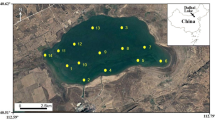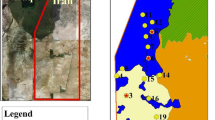Abstract
Coastal wetlands are the last barriers for pollutants from land to the sea. In this study, a coastal wetland that locates in the lower reach of Haihe River Systems was selected to speculate the removal and retention of polycyclic aromatic hydrocarbons (PAHs) by analyzing their spatial distributions and the changes of composition. The results showed that the overall removal efficiency of PAHs in water phase was 58.1%. There was an accumulation for sedimentary PAHs, reaching 431 ng/g (181 ng/g in the inlet). The compositions of sedimentary PAHs were also changed, high-molecular-weight PAHs were the main component (70−50%), with a steady decreasing trend and the influence of water flow direction. The risk assessment by mean effect range media quotients (M-ERM-Qs) depicted that there was in low ecological risk, due to the degradation of PAHs in the wetlands. Our results clearly demonstrated the coastal wetlands could effectively retain the PAHs, thus we recommend an active protection strategy for the coast wetlands in Tianjin in the future.




Similar content being viewed by others
References
Ashayeri NY, Keshavarzi B, Moore F et al (2018) Presence of polycyclic aromatic hydrocarbons in sediments and surface water from Shadegan wetland – Iran: a focus on source apportionment human and ecological risk assessment and sediment-water exchange. Ecotoxicol Environ Saf 148:1054–1066
Balgobin A, Singh NR (2019) Source apportionment and seasonal cancer risk of polycyclic aromatic hydrocarbons of sediments in a multi-use coastal environment containing a Ramsar wetland, for a Caribbean island. Sci Total Environ 664:474–486
Barakat AO, Mostafa A, Wade TL et al (2011) Distribution and characteristics of PAHs in sediments from the Mediterranean coastal environment of Egypt. Mar Pollut Bull 62:1969–1978
Binelli A, Sarkar SK, Chatterjee M et al (2008) A comparison of sediment quality guidelines for toxicity assessment in the Sunderban wetlands (Bay of Bengal India). Chemosphere 73:1129–1137
Dudhagara DR, Rajpara RK, Bhatt JK et al (2016) Distribution, sources and ecological risk assessment of PAHs in historically contaminated surface sediments at Bhavnagar coast, Gujarat, India. Environ Pollut 213:338–346
Gu YG, Ke CL, Gao YP et al (2020) Nonmetric multidimensional scaling and adverse effects on aquatic biota of polycyclic aromatic hydrocarbons in sediments: a case study of a typical aquaculture wetland, China. Environ Res 182:109119
Hao J, Xu GY, Luo L et al (2020) Quantifying the relative contribution of natural and human factors to vegetation coverage variation in coastal wetlands in China. Catena 188:104429
Hong WJ, Jia HL, Li YF et al (2016) Polycyclic aromatic hydrocarbons (PAHs) and alkylated PAHs in the coastal seawater, surface sediment and oyster from Dalian, northeast China. Ecotoxicol Environ Saf 128:11–20
Jung JA, Rogers HN, Grabas GP (2020) Refinement of an index of ecological condition for masrsh bird communities in lower Great Lakes coastal wetlands. Ecol Indic 113:106097
Lei P, Zhang H, Shan BQ (2016) Vertical records of sedimentary PAHs and their freely dissolved fraction in porewater profiles from the northern bays of Taihu Lake, Eastern China. RSC Adv 6:98835–98844
Lei P, Pan K, Zhang H et al (2019) Pollution and risk of PAHs in surface sediments from the tributaries and their relation to anthropogenic activities, in the main urban districts of Chongqing city, Southwest China. B Environ Contam Tox 103:28–33
Lin FX, Han B, Ding Y et al (2018) Distribution characteristics, sources, and ecological risk assessment of polycyclic aromatic hydrocarbons in sediments from the Qinhuangdao coastal wetland, China. Mar Pollut Bul 127:788–793
Liu N, Zhang DL, Cen K et al (2018) Influence of anthropogenic activities on the temporal and spatial variation of polycyclic aromatic hydrocarbons in the sediments of Jiangsu coastal zone, China. Cont Shelf Res 1701:11–20
Ma CL, Lin T, Ye SY et al (2017) Sediment record of polycyclic aromatic hydrocarbons in the Liaohe River Delta wetland, Northeast China: implications for regional population migration and economic development. Environ Pollut 222:146–152
Nascimento RA, De Almeida M, Escobar NCF et al (2017) Sources and distribution of polycyclic aromatic hydrocarbons (PAHs) and organic matter in surface sediments of an estuary under petroleum activity influence, Todos os Santos Bay, Brazil. Mar Pollut Bull 119:223–230
Pernet-Coudrier B, Qi WX, Liu HJ et al (2012) Sources and pathways of nutrients in the semi-arid region of Beijing Tianjin, China. Environ Sci Technol 46:5294–5301
Qi WX, Liu HJ, Pernet-Coudrier B et al (2013) Polycyclic aromatic hydrocarbons in wastewater, WWTPs effluents and in the recipient waters of Beijing, China. Environ Sci Pollut Res 20:4254–4260
Qiao M, Qi WX, Liu HJ et al (2014) Oxygenated, nitrated, methyl and parent polycyclic aromatic hydrocarbons in rivers of Haihe River System, China: occurrence, possible formation, and source and fate in a water-shortage area. Sci Total Environ 481:178–185
Tang WZ, Mao ZP, Zhang H,et al (2015) Water resources: the prerequisite for ecological restoration of rivers in the Hai River Basin, northern China. Environ Sci Pollut Res 22:1359–1365
Tao YQ, Yu J, Xue B et al (2017) Precipitation and temperature drive seasonal variation in bioaccumulation of polycyclic aromatic hydrocarbons in the planktonic food webs of a subtropical shallow eutrophic lake in China. Sci Total Environ 583:447–457
Terzakis S, Fountoulakis MS, Georgaki I,et al (2008) Constructed wetlands treating highway runoff in the central Mediterranean region. Chemosphere 72:141–149
Vollenweider RA (1969) A manual on methods for measuring primary production in aquatic environments. Blackwell Scientific Publishers, Oxford
Wang ZP, Fan AX, Tang WZ et al (2020) Spatial distribution, sources and risks of polycyclic aromatic hydrocarbons in sediments from Ziya River system, northern China. B Environ Contam Tox 1–7
Xu YC, Liu TJ, Zhu XF et al (2019) Quantitative analysis of genetic associations in the biodegradative pathway of PAHs in wetland sediments of the Bohai coast region. Chemsphere 218:282–292
Zhang FK, Xie HS, Liu HL et al (2013) Sediment and water quality characteristics of wetlands in Tianjin Binhai New Area. Urban Environ Urban Ecol 26(1):41–43 (In Chinese)
Zhao GF, Zhou HD, Liu XR et al (2012) PHAHs in 14 principal river sediments from Hai River Basin, China. Sci Total Environ 427–428:139–145
Zheng GJ, Man BKW, Lam JCW et al (2002) Distribution and sources of polycyclic aromatic hydrocarbons in the sediments of a sub-tropical coastal wetland. Water Res 36:1457–1468
Zheng J, Wang W, Yin C (2012) Distribution and retention of PAHs in a constructed wetland in the Yangtze River Delta, China. Fresen Environl Bull 21:2594–2602
Zhu XL, Shan BQ, Tang WZ (2016) Heavy metal in sediments of Ziya River in northern China: distribution, potential risks, and source apportionment. Environ Sci Pollut Res 23:1–11
Acknowledgements
This research is financially supported by the Tianjin Science and Technology Projects (Nos. 18ZYYFSF00010 and 18ZYPTSF00050), and The Major Science and Technology Projects for Water Pollution Control and Treatment Projects (No. 2017ZX07107-004). And Ms. Hui Li is appreciated for her help in literature review during this study.
Author information
Authors and Affiliations
Corresponding author
Additional information
Publisher's Note
Springer Nature remains neutral with regard to jurisdictional claims in published maps and institutional affiliations.
Rights and permissions
About this article
Cite this article
Wang, N., Wang, J., Li, Y. et al. Occurrences, Retention and Risk Assessments of PAHs in Beidagang Wetland in Tianjin, China. Bull Environ Contam Toxicol 105, 607–612 (2020). https://doi.org/10.1007/s00128-020-02997-5
Received:
Accepted:
Published:
Issue Date:
DOI: https://doi.org/10.1007/s00128-020-02997-5




